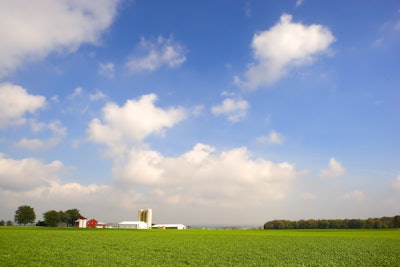
Recommended citation format: Good, D., and S. Irwin. "Weekly Outlook: A Review of USDA Crop Yield Forecasting Methodology." farmdoc daily (5):144, Department of Agricultural and Consumer Economics, University of Illinois at Urbana-Champaign, August 10, 2015.
Permalink: https://farmdocdaily.illinois.edu/2015/08/review-usda-crop-yield-forecasting-methodology.html
The USDA's National Agricultural Statistics Service (NASS) will release the first survey-based yield and production forecasts for the 2015 corn and soybean crops on August 12. We provided a comprehensive review of the NASS forecasting methodology in a Marketing and Outlook Brief in 2011and NASS provides a very detailed description of the methodology in the publication Understanding USDA Crop Forecasts. In addition, a summary of survey and estimation methodology is included with each Crop Production report.
Even though a description of the NASS crop production forecast methodology is widely available, there always seems to be some misconceptions about how NASS makes corn and soybean yield forecasts. A brief overview of that methodology is repeated here. While this summary does not do full justice to the very comprehensive forecasting methodology, it is presented to assist in placing the upcoming yield forecasts in the proper perspective.
NASS corn and soybean yield forecasts are made in August, September, October and November. The final yield estimate is released in January after harvest based on the comprehensive December Agricultural Survey of producers. Two types of surveys are used to collect data for the monthly NASS forecasts in August through November. The Monthly Agricultural Yield Survey (AYS) of producers is conducted in 32 states for corn and 29 states for soybeans with a total of about 25,000 producers surveyed for all crops in August. The Objective Yield Survey (OYS) is conducted in 10 states for corn and 11 states for soybeans. The surveys are generally conducted in a two week period ending about a week before the release of the forecasts.
For the AYS, a sample of farm operations to be surveyed is drawn from those who responded to the acreage survey in June. While the sample of operations to be surveyed changes from year-to-year, for any particular year the same operations are interviewed each month from August through November. Survey respondents are asked to identify the number of acres of corn and soybeans to be harvested and to provide a forecast of the final yield of each crop. Based on these responses, average yields are forecast for each survey state and for the U.S.
The goal of the OYS program is to generate yield forecasts based on actual plant counts and measurements .The sample of fields (1,920 for corn and 1,835 for soybeans) for the OYS survey is selected from farms that reported corn (soybeans) planted or to be planted in the June acreage survey. A random sample of fields is drawn with the probability of selection of any particular field being proportional to the size of the tract and two plots are randomly selected in each field. Data collected from each corn plot during the forecast cycle are used to measure the size of the unit and to measure or forecast the number of ears and grain weight. These data include (as available based on maturity) row width, number of stalks per row, number of stalks with ears or ear shoots per row, number of ears with kernels, kernel row length, ear diameter, ear weight in dent stage, weight of shelled grain, moisture content, total ear weight of harvested unit, lab weight of sample ears, weight of grain from sample ears, and moisture content of shelled grain from sample of mature ears. Corn yield is forecast based on the forecast (or measurement if maturity allows) of the number of ears, the weight per ear, and harvest loss.
Data collected from soybean plots (as available based on maturity) include row width; number of plants in each row; number of main stem modes, lateral branches, dried flowers and pods, and pods with beans; weight and moisture content of beans harvested by enumerator; and weight and moisture content of harvest loss. The data collected are used to forecast yield based on a forecast (or measurement if maturity allows) of the number of plants per acre, the number of pods with beans per plant, the average bean weight, and harvest loss.
For both corn and soybeans, the state average yield forecast based on the OYS is the simple average of the yields for all the sample fields. In addition, a state yield forecast is also made by first averaging the forecast or actual yield factors (such as stalk counts, ear counts, and ear weight) and then forecasting the state average yield directly from these averages. This forecast is based on a regression analysis of the historical relationship (15 years) between the yield factors and the state average yield. State average yields are combined to forecast the U.S. average yield.
The NASS corn and soybean survey and forecasting procedures produce a number of indictors of the average yield. In August these indicators include: average field level yields from the OYS, average state level counts from the OYS, and the average yield reported by farmers in the AYS. Each of the indicators provides input into the determination of the official yield forecasts by the USDA's Agricultural Statistics Board.
The accuracy of the USDA yield forecasts relative to the final yield estimates varies from year to year, but as would be expected, improves each month through the forecast cycle as the crops become more mature. A year ago, we provided a comprehensive analysis of the NASS yield forecasting accuracy for corn and soybeans.
References
Good, D., and S. Irwin. "USDA Corn and Soybean Acreage Estimates and Yield Forecasts: Dispelling Myths and Misunderstandings." MOBR 11-02, Department of Agricultural and Consumer Economics, University of Illinois at Urbana-Champaign, March 23, 2011.
Irwin, S., D. Good, and D. Sanders. "Are USDA Soybean Yield Forecasts Getting Better or Worse over Time?" farmdoc daily (4):169, Department of Agricultural and Consumer Economics, University of Illinois at Urbana-Champaign, September 4, 2014.
Irwin, S., D. Good, and D. Sanders. "Are USDA Corn Yield Forecasts Getting Better or Worse over Time?" farmdoc daily (4):166, Department of Agricultural and Consumer Economics, University of Illinois at Urbana-Champaign, August 29, 2014.
Vogel, Frederic A., and Gerald A. Bange. "Understanding Crop Statistics." USDA Miscellaneous Publication No. 1554. Accessed August 10, 2015.https://www.nass.usda.gov/Education_and_Outreach/Understanding_Statistics/pub1554.pdf

















